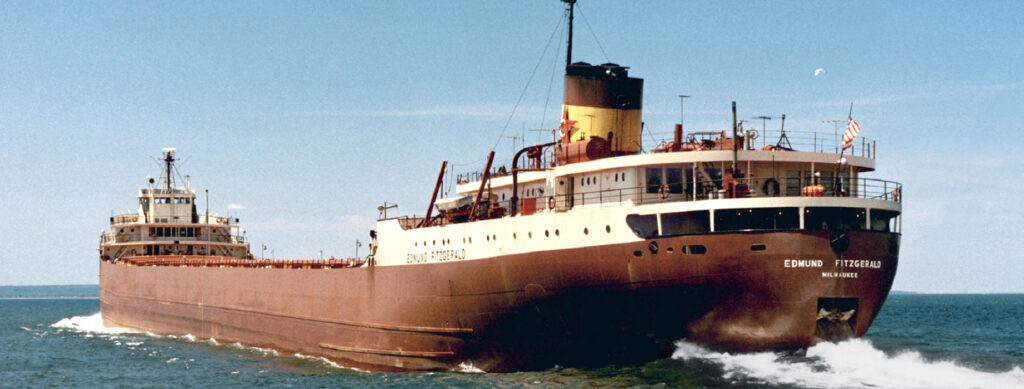The Ojibwe Tribe that once lived by the northern Great Lakes named Lake Superior, Gichi-Gami, which means great sea. Lake Superior is not an ocean, but it can be just as treacherous as one.
People familiar with Lake Superior say it almost has a pulse and its mood swings quickly from benign to angry in minutes. The lake’s large size provides hundreds of miles, allowing huge waves to develop. Rogue waves, including a phenomenon called the Three Sisters, can occur. The Three Sisters is a series of three extra-large waves that follow each other so closely that ships do not have time to recover before the next wave hits. It is not surprising that Lake Superior is littered with shipwrecks, the greatest of which is the Edmund Fitzgerald, made famous by Gordon Lightfoot’s song, The Wreck of the Edmund Fitzgerald.

The Edmund Fitzgerald was lost along with her entire crew of 29 men on Lake Superior on November 10, 1975, 17 miles north-northwest of Whitefish Point, Michigan. What caused her to sink remains controversial, although her captain, Captain McSorley, reported having difficulties during the storm. No distress signals were ever sent, and no bodies were ever recovered from the wreckage. Later, when the wreck was found, it was discovered that the ship had broken in half.
The Edmund Fitzgerald was named after the President and Chairman of the Board of Northwestern Mutual. She was launched on June 8, 1958 at River Rouge, Michigan. She was 729 feet long, weighing 13,632 gross tons, and the largest vessel on the Great Lakes at the time.
The final voyage of the Edmund Fitzgerald began on November 9, 1975. She left the port of Superior, Wisconsin loaded with 26,116 long tons of taconite pellets. Captain Ernest M. McSorley departed the port about 2:30 pm and was joined by the Arthur M. Anderson, which had departed from Two Harbors, Minnesota under Captain Bernie Cooper.
Captain McSorley and Captain Cooper decided to take the northerly course across Lake Superior because of a forecast gale. The high shoreline would provide them with some protection before they reached the shelter of Whitefish Point.
Later, the forecast was upgraded to a storm warning. The next morning, November 10, conditions were bad. Winds were gusting to 50 knots, and the seas were running 16 feet. In the afternoon, the Fitzgerald passed Michipicoten Island and approached Caribou Island with the Anderson about ten miles behind.
Captain McSorley radioed Captain Cooper about 3:30 and said: “Anderson, this is the Fitzgerald. I have a fence rail down, two vents lost or damaged, and a list. I’m checking down. Will you stay by me till I get to Whitefish?”, meaning he was slowing down. Captain Cooper asked McSorley if he had his pumps going, and McSorley said, “Yes, both of them.”
At about 5:20 pm, the crest of a wave smashed the Anderson’s starboard lifeboat, making it unusable. By 5:00, Captain Cooper reported winds from the NW at a steady 58 knots with gusts to 70 knots, and seas of 18 to 25 feet.
Anderson’s first mate spoke to the Fitzgerald one last time, about 7:10 pm:
“Fitzgerald, this is the Anderson. Have you checked down?”
“Yes, we have.”
“Fitzgerald, we are about 10 miles behind you and gaining about 1 1/2 miles per hour. Fitzgerald, there is a target 19 miles ahead of us. So, the target would be 9 miles ahead of you.”
“Well,” answered Captain McSorley, “Am I going to clear?”
“Yes, he is going to pass to the west of you.”
“Well, fine.”
“By the way, Fitzgerald, how are you making out with your problems?” asked Clark.
“We are holding our own.”
“Okay, fine, I’ll be talking to you later.” The first mate signed off.
But that was the last time anyone spoke with the Fitzgerald. At about 6:55 pm, Captain Cooper felt the ship lurch and turned to see a monstrous wave engulfing his entire vessel from astern. The wave crashed into the back of the Anderson’s pilothouse, driving the bow of the ship down into the sea.
“Then the Anderson just raised and shook herself of all that water, just like a big dog. Another wave, just like the first one, or bigger hit us again. I watched those two waves head down the lake towards the Fitzgerald, and I think those were the two that sent her under.”
Around 7:15 pm, the Fitzgerald’s pip on the radar screen disappeared and did not reappear. The Anderson called the Fitzgerald again at about 7:22 pm. There was no answer. Captain Cooper contacted other ships in the area, asking if anyone had seen or heard from the Fitzgerald. No one had.
On April 15, 1977, the U.S. Coast Guard released its official report on the sinking of the Edmund Fitzgerald. The Coast Guard said the cause of the sinking could not be conclusively determined, but maintained “the most probable cause of the sinking of the S.S. Edmund Fitzgerald was the loss of buoyancy and stability resulting from massive flooding of the cargo hold. The flooding of the cargo hold took place through ineffective hatch closures as boarding seas rolled along the spar deck.”
The wreck of the Edmund Fitzgerald lies in 530 feet of water. Later, expeditions revealed that it is likely she “submarined” bow first into an enormous sea. This is because the damage forward to her superstructure is indicative of a powerful, quick force. Although Captain Cooper of the Anderson said he saw only two giant waves, perhaps it was the dreaded Three Sisters that sank the Edmund Fitzgerald, taking all 29 crewmen to their deaths.
